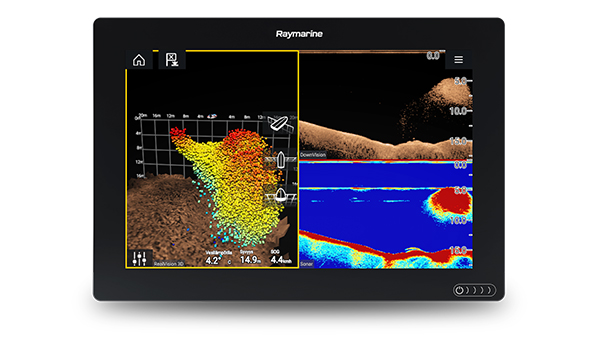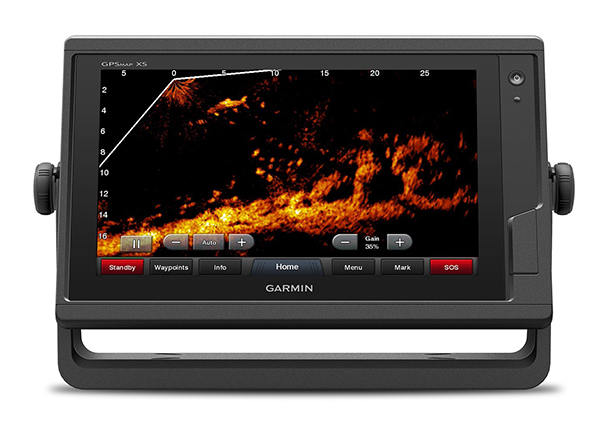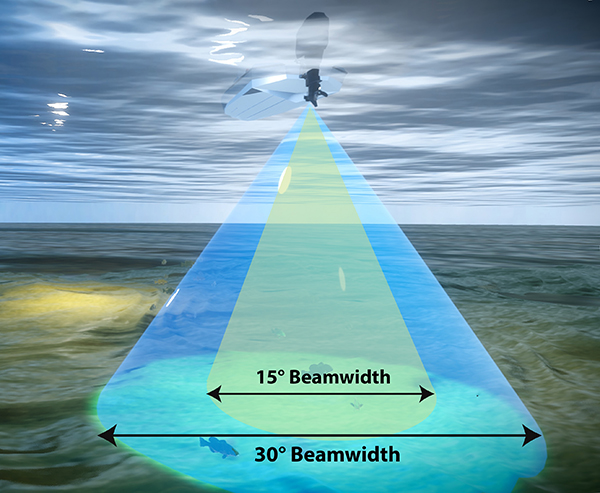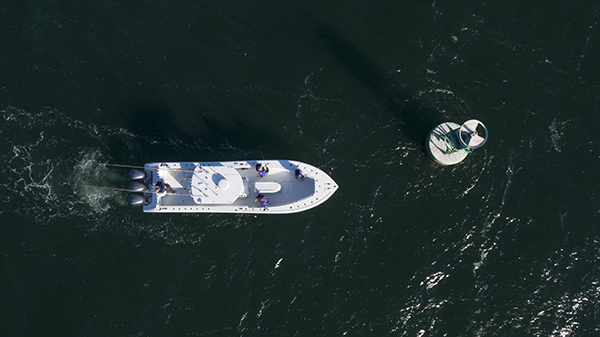Today’s marine electronics give anglers the tools needed to skip the lengthy search for fish and proceed directly to the fun part: catching them!
If you’re one of those people who don’t replace anything until it breaks and this also includes your fishfinder/GPS, there’s a good chance you have been left behind during the most amazing periods of advancement in marine electronics history. The biggest quantum leap occurred in 2009 when CHIRP technology migrated from the military to recreational fishing. Previously, sonar signals from fishfinders were a single-frequency, short-duration pulse sent out and returned that sometimes created an uncertain image on the screen… especially on the bottom. Is that a rock or a big fish? Higher in the column, the separation was such it was sometimes hard to distinguish between weeds and fish, and between big and small fish. The older units required experienced eyes to know what they were seeing.

CHIRP sonar bombards the target with 10 to 1,000 times the sound energy of a legacy fishfinder, using many alternating long-duration frequencies that return to a broadband transducer and are then translated by the fishfinder’s digital signal processor to create incredibly detailed screen images with unparalleled separation, even when the boat is on plane. Previously, this amazing technology was only available on the most expensive units, but now it’s even available on budget units like the $120 Lowrance® Hook2 4x that comes complete with a bullet transducer.
See Schools of Fish in 3D
Raymarine’s® RealVision® 3D is the perfect weapon for locating fish holding near structure. When trolling or drifting over an area of interest, its special transducer begins marking the bottom and any fish in the area. What makes it different is the more passes you make, the more detail is revealed until there is a near-photographic depiction of the bottom. A pan and tilt feature allows the user to use the touchscreen to view the images from any perspective and waypoints can be placed on any areas of interest. The position of fish schools is repainted on subsequent passes to give real-time information and they can be color-coded by depth or by fish density, allowing the user to quickly spot where the big ones are lurking. You can even scroll back 10 minutes in time. An internal gyro-stabilizing function prevents the motion of the water from altering the depiction on the screen. RealVision® 3D is surprisingly affordable; an AXIOM+® 7 RV, Multi-function 7” Display with integrated RealVision 3D, 600W Sonar with RV-100 All-In-One transducer has a list price of $1,250.

A Fishfinder That Lets You See Fish Swimming
One of the most startling new fishfinder technologies is Panoptix LiveScopeTM from Garmin® and it gives anglers a view they’ve never seen before: fish swimming in real-time. On traditional fishfinder screens, the majority of what you see is the history of what happened moments before. With LiveScope, not only can you see the fish well enough to often tell its species, you can even see your lure as it’s being presented. This live-streaming technology should appeal especially to young anglers since it essentially turns fishing into a video game. When viewed in Down mode, dropping a lure gives immediate feedback whether it’s attracting a fish’s attention.
Panoptix LiveScope TM uses a special transducer that can be mounted to a trolling motor or to a pole that can be swiveled to scan a 360-degree field surrounding the boat with a radius of 200 yards. It makes finding fish pretty easy; if you see them swimming, they’re there, if you don’t, there are no fish in the vicinity. It can also be used when trolling. Simply position the transducer to look rearward and start trolling. If fish are present, you will see them and can circle back to target that area if the fish don’t bite on the first pass. The price is surprisingly affordable. A LiveScope LVS12 transducer ($499) provides an economical solution for the Garmin® GPSMAP® 8400/8600xsv series — without the need for a black box. It gives the user a 30-degree forward and 30-degree down real-time scanning sonar view.

Black Boxes
The problem with buying electronics is it doesn’t take long for its technology to become dated. This is especially problematic when buying a big-screen multi-function display (MFD). But fortunately, that $6,000 15-inch MFD can stay upgraded with the addition of a sonar module, aka a black box. In the case of Garmin’s® Panoptix LiveScopeTM feature, upgrading to the GLS 10 sonar black box with LVS32 transducer ($1,500) provides many benefits like a field of vision expanded to 135 degrees instead of the 30-degree view with the transducer alone.
Popular features like SideScan, DownScan and CHIRP sonar can be added via black box. Some, like the Simrad® SonarHub® Sounder Module ($1,000) bundle all these elements, and the Simrad® bundle and also adds StructureScan® and Spotlightscan® transducer elements. SideScan allows fishermen to cruise by docks, mangroves and jetties and see if any fish are present. Though the structures themselves appear in near-photographic representation, fish appear as lighter-colored dots, but once you know what to look for, it’s a powerful tool that saves countless time.
Get the Right Transducer
If you’ve upgraded to a new fishfinder but decided to save a little money by keeping your old transducer, that could be the equivalent of buying a Ferrari® and putting a VW® engine in it. Although a CHIRP-ready MFD will operate with a non-CHIRP transducer, the image on the screen will be compromised. Also, pairing a fishfinder/GPS with the right transducer for your specific type of fishing is critical. Some work better at certain depths than others.
Airmar is the undisputed leader in transducer technology and their engineers have several new designs that can help catch more fish. A problem with conventional transducers is the relatively narrow beamwidth they throw. Airmar’s® TM165HW wide-beam transducer ($499) widens the cone to cover three times more area with its 30-degree beamwidth. It utilizes the 150-250 kHz bandwidths, which are most useful in shallower water where most anglers fish.
Because many fish-finding technologies require specialized transducers, those that can perform two or more functions are useful and help keep installations clean. Raymarine® takes this concept to the max with its RV-100 All-In-One transducer that can handle five simultaneous functions: RealVision 3D, SideView, DownView, low-power/high-frequency CHIRP, 1kW high-power CHIRP and in low/medium/high frequencies (50/80/100/160/200 kHz).

Take Control with Helm Master®
Upgrading to Yamaha’s Helm Master® EX integrated control system gives anglers far more than just joystick docking. Think of it as an additional captain at the wheel who can make advanced maneuvering look easy. For fishing, its SetPoint® features are among its most important. The system uses a combination of a GPS antennae and multi-axis heading sensor to allow the boat to be controlled like never before. Its three modes, FishPoint®, DriftPoint® and StayPoint®, orient a boat in the most advantageous position for every fishing situation. StayPoint keeps it “anchored” in position while keeping the bow pointed in the direction the driver chooses. For a stealthier presence, FishPoint keeps the boat over a specific location but the boat can point in any direction, which reduces the number of shifts. DriftPoint allows a boat to drift with the wind or tide while keeping the bow oriented in a specific direction. DriftPoint Track allows the driver to input a series of GPS waypoints, which is useful when fishing the edge of a reef or following a depth contour. Corrections can be quickly made by jogging or twisting the joystick. A new feature called Pattern Shift allows the driver to decide what percentage of time the boat stays in gear for perfectly controlled slow trolling. This year, even single-engine boat owners can enjoy the benefits of Helm Master EX technology with surprisingly few limitations.
Use 100 Percent of Your Fishfinder’s Brain
Modern fishfinders are easier to operate than those of previous generations, thanks to features like sophisticated auto-tuning programs, but there’s still a significant learning curve. To get the most out of your electronics, your first step should be to open the owner’s manual. While some are written in language that’s not always “goodly,” the main mission is to see what features are included and what each button or control feature does. Your best learning tool is the internet, and the best way to hone in on getting the most features is to perform specific searches. A good first step is a generic search that targets your fishfinder’s specific model. If you are doing a Google® search, place the exact model number in quotation marks and all the results will include that model. You can exclude words that clutter your search results by including a – symbol before each word you want to eliminate from the results. YouTube® has the most tutorials from a wide range of posters, and it’s a good idea to look at the number of people who have viewed it or the names of the posters who are often well-known professional anglers.
The main things to learn with a new fishfinder are how to adjust the gain or sensitivity to eliminate clutter and how to set the zoom to better highlight the fish-catching zone.
Another valuable feature is the ability to customize the color palette; every person has a preferred color that helps to interpret what is being seen. The ability to set split screens takes advantage of a fishfinder’s multitasking prowess.
Upgrade the Cartography
Almost all fishfinders have a slot for memory chips, and one of the most significant upgrades an angler can make is to upgrade the cartography. Having advanced charts of your usual fishing area is one of the best fish-finding tools available. Most interface with the fishfinder to perform tasks like color-coordinating depth gradients so if the fish are biting in 15-20 feet of water, you can quickly scan for other compatible areas. Some even have known fishing spots highlighted along with additional information about the best time of year to work a spot and what the fish typically eat there.
Back to Blue Life
If you’re one of those people who don’t replace anything until it breaks and this also includes your fishfinder/GPS, there’s a good chance you have been left behind during the most amazing periods of advancement in marine electronics history. The biggest quantum leap occurred in 2009 when CHIRP technology migrated from the military to recreational fishing. Previously, sonar signals from fishfinders were a single-frequency, short-duration pulse sent out and returned that sometimes created an uncertain image on the screen… especially on the bottom. Is that a rock or a big fish? Higher in the column, the separation was such it was sometimes hard to distinguish between weeds and fish, and between big and small fish. The older units required experienced eyes to know what they were seeing.

CHIRP sonar bombards the target with 10 to 1,000 times the sound energy of a legacy fishfinder, using many alternating long-duration frequencies that return to a broadband transducer and are then translated by the fishfinder’s digital signal processor to create incredibly detailed screen images with unparalleled separation, even when the boat is on plane. Previously, this amazing technology was only available on the most expensive units, but now it’s even available on budget units like the $120 Lowrance® Hook2 4x that comes complete with a bullet transducer.
See Schools of Fish in 3D
Raymarine’s® RealVision® 3D is the perfect weapon for locating fish holding near structure. When trolling or drifting over an area of interest, its special transducer begins marking the bottom and any fish in the area. What makes it different is the more passes you make, the more detail is revealed until there is a near-photographic depiction of the bottom. A pan and tilt feature allows the user to use the touchscreen to view the images from any perspective and waypoints can be placed on any areas of interest. The position of fish schools is repainted on subsequent passes to give real-time information and they can be color-coded by depth or by fish density, allowing the user to quickly spot where the big ones are lurking. You can even scroll back 10 minutes in time. An internal gyro-stabilizing function prevents the motion of the water from altering the depiction on the screen. RealVision® 3D is surprisingly affordable; an AXIOM+® 7 RV, Multi-function 7” Display with integrated RealVision 3D, 600W Sonar with RV-100 All-In-One transducer has a list price of $1,250.

A Fishfinder That Lets You See Fish Swimming
One of the most startling new fishfinder technologies is Panoptix LiveScopeTM from Garmin® and it gives anglers a view they’ve never seen before: fish swimming in real-time. On traditional fishfinder screens, the majority of what you see is the history of what happened moments before. With LiveScope, not only can you see the fish well enough to often tell its species, you can even see your lure as it’s being presented. This live-streaming technology should appeal especially to young anglers since it essentially turns fishing into a video game. When viewed in Down mode, dropping a lure gives immediate feedback whether it’s attracting a fish’s attention.
Panoptix LiveScope TM uses a special transducer that can be mounted to a trolling motor or to a pole that can be swiveled to scan a 360-degree field surrounding the boat with a radius of 200 yards. It makes finding fish pretty easy; if you see them swimming, they’re there, if you don’t, there are no fish in the vicinity. It can also be used when trolling. Simply position the transducer to look rearward and start trolling. If fish are present, you will see them and can circle back to target that area if the fish don’t bite on the first pass. The price is surprisingly affordable. A LiveScope LVS12 transducer ($499) provides an economical solution for the Garmin® GPSMAP® 8400/8600xsv series — without the need for a black box. It gives the user a 30-degree forward and 30-degree down real-time scanning sonar view.

Black Boxes
The problem with buying electronics is it doesn’t take long for its technology to become dated. This is especially problematic when buying a big-screen multi-function display (MFD). But fortunately, that $6,000 15-inch MFD can stay upgraded with the addition of a sonar module, aka a black box. In the case of Garmin’s® Panoptix LiveScopeTM feature, upgrading to the GLS 10 sonar black box with LVS32 transducer ($1,500) provides many benefits like a field of vision expanded to 135 degrees instead of the 30-degree view with the transducer alone.
Popular features like SideScan, DownScan and CHIRP sonar can be added via black box. Some, like the Simrad® SonarHub® Sounder Module ($1,000) bundle all these elements, and the Simrad® bundle and also adds StructureScan® and Spotlightscan® transducer elements. SideScan allows fishermen to cruise by docks, mangroves and jetties and see if any fish are present. Though the structures themselves appear in near-photographic representation, fish appear as lighter-colored dots, but once you know what to look for, it’s a powerful tool that saves countless time.
Get the Right Transducer
If you’ve upgraded to a new fishfinder but decided to save a little money by keeping your old transducer, that could be the equivalent of buying a Ferrari® and putting a VW® engine in it. Although a CHIRP-ready MFD will operate with a non-CHIRP transducer, the image on the screen will be compromised. Also, pairing a fishfinder/GPS with the right transducer for your specific type of fishing is critical. Some work better at certain depths than others.
Airmar is the undisputed leader in transducer technology and their engineers have several new designs that can help catch more fish. A problem with conventional transducers is the relatively narrow beamwidth they throw. Airmar’s® TM165HW wide-beam transducer ($499) widens the cone to cover three times more area with its 30-degree beamwidth. It utilizes the 150-250 kHz bandwidths, which are most useful in shallower water where most anglers fish.
Because many fish-finding technologies require specialized transducers, those that can perform two or more functions are useful and help keep installations clean. Raymarine® takes this concept to the max with its RV-100 All-In-One transducer that can handle five simultaneous functions: RealVision 3D, SideView, DownView, low-power/high-frequency CHIRP, 1kW high-power CHIRP and in low/medium/high frequencies (50/80/100/160/200 kHz).

Take Control with Helm Master®
Upgrading to Yamaha’s Helm Master® EX integrated control system gives anglers far more than just joystick docking. Think of it as an additional captain at the wheel who can make advanced maneuvering look easy. For fishing, its SetPoint® features are among its most important. The system uses a combination of a GPS antennae and multi-axis heading sensor to allow the boat to be controlled like never before. Its three modes, FishPoint®, DriftPoint® and StayPoint®, orient a boat in the most advantageous position for every fishing situation. StayPoint keeps it “anchored” in position while keeping the bow pointed in the direction the driver chooses. For a stealthier presence, FishPoint keeps the boat over a specific location but the boat can point in any direction, which reduces the number of shifts. DriftPoint allows a boat to drift with the wind or tide while keeping the bow oriented in a specific direction. DriftPoint Track allows the driver to input a series of GPS waypoints, which is useful when fishing the edge of a reef or following a depth contour. Corrections can be quickly made by jogging or twisting the joystick. A new feature called Pattern Shift allows the driver to decide what percentage of time the boat stays in gear for perfectly controlled slow trolling. This year, even single-engine boat owners can enjoy the benefits of Helm Master EX technology with surprisingly few limitations.
Use 100 Percent of Your Fishfinder’s Brain
Modern fishfinders are easier to operate than those of previous generations, thanks to features like sophisticated auto-tuning programs, but there’s still a significant learning curve. To get the most out of your electronics, your first step should be to open the owner’s manual. While some are written in language that’s not always “goodly,” the main mission is to see what features are included and what each button or control feature does. Your best learning tool is the internet, and the best way to hone in on getting the most features is to perform specific searches. A good first step is a generic search that targets your fishfinder’s specific model. If you are doing a Google® search, place the exact model number in quotation marks and all the results will include that model. You can exclude words that clutter your search results by including a – symbol before each word you want to eliminate from the results. YouTube® has the most tutorials from a wide range of posters, and it’s a good idea to look at the number of people who have viewed it or the names of the posters who are often well-known professional anglers.
The main things to learn with a new fishfinder are how to adjust the gain or sensitivity to eliminate clutter and how to set the zoom to better highlight the fish-catching zone.
Another valuable feature is the ability to customize the color palette; every person has a preferred color that helps to interpret what is being seen. The ability to set split screens takes advantage of a fishfinder’s multitasking prowess.
Upgrade the Cartography
Almost all fishfinders have a slot for memory chips, and one of the most significant upgrades an angler can make is to upgrade the cartography. Having advanced charts of your usual fishing area is one of the best fish-finding tools available. Most interface with the fishfinder to perform tasks like color-coordinating depth gradients so if the fish are biting in 15-20 feet of water, you can quickly scan for other compatible areas. Some even have known fishing spots highlighted along with additional information about the best time of year to work a spot and what the fish typically eat there.
Back to Blue Life
